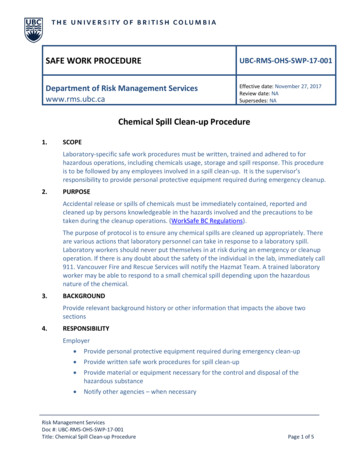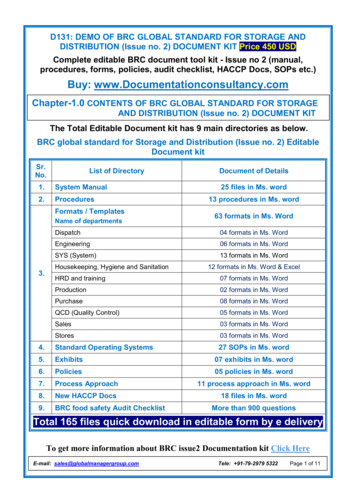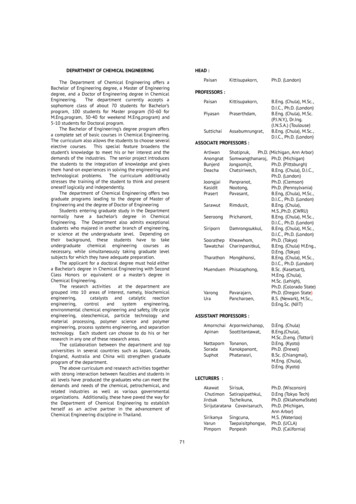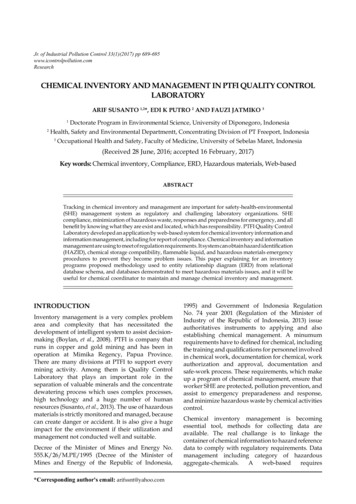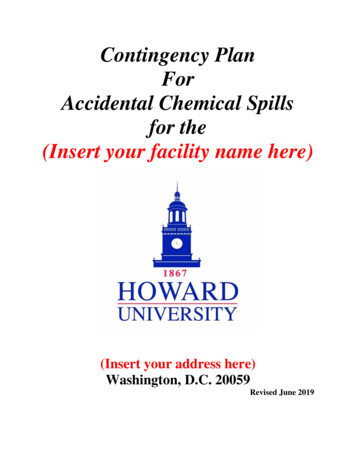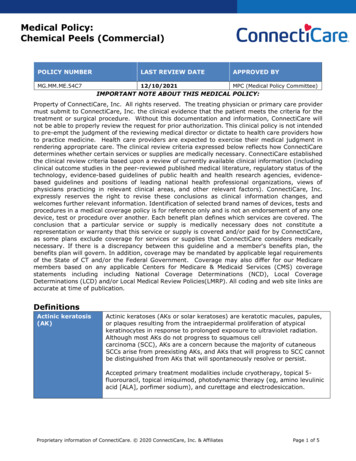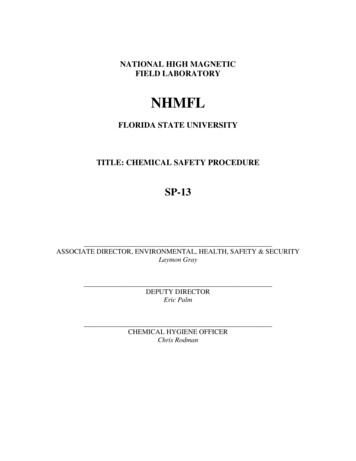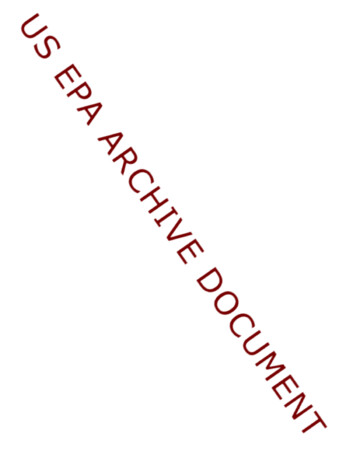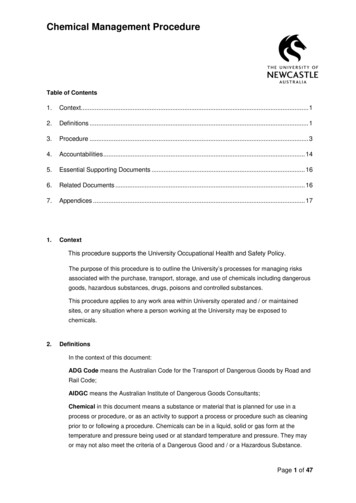
Transcription
Chemical Management ProcedureTable of Contents1.Context. 12.Definitions . 13.Procedure . 34.Accountabilities . 145.Essential Supporting Documents . 166.Related Documents . 167.Appendices . 171.ContextThis procedure supports the University Occupational Health and Safety Policy.The purpose of this procedure is to outline the University’s processes for managing risksassociated with the purchase, transport, storage, and use of chemicals including dangerousgoods, hazardous substances, drugs, poisons and controlled substances.This procedure applies to any work area within University operated and / or maintainedsites, or any situation where a person working at the University may be exposed tochemicals.2.DefinitionsIn the context of this document:ADG Code means the Australian Code for the Transport of Dangerous Goods by Road andRail Code;AIDGC means the Australian Institute of Dangerous Goods Consultants;Chemical in this document means a substance or material that is planned for use in aprocess or procedure, or as an activity to support a process or procedure such as cleaningprior to or following a procedure. Chemicals can be in a liquid, solid or gas form at thetemperature and pressure being used or at standard temperature and pressure. They mayor may not also meet the criteria of a Dangerous Good and / or a Hazardous Substance.Page 1 of 47
Chemicals may include a commonly used product such as water or pipednatural gas, where those products are in volumes that may create a high level of risk.Dangerous Goods means substances that are potentially hazardous to people andproperty, and are classified according to their immediate physical or chemical properties as:a) Substances or articles that under the ADG Code are listed or described as:(i) dangerous goods of Class 2, 3, 4, 5, 6.1, 8 or 9, or(ii) goods too dangerous to be transported,b) or are C1 combustible liquids;Hazardous Area means an area or space in which the atmosphere contains or mayreasonably be expected to contain any material or substance (including, but not limited to,combustible dusts, combustible fibres, flammable vapours, flammable liquids, flammablegases, flammable or combustible fumes) at a concentration that is capable of being ignitedby an ignition source.Hazardous Substance means a substance that has the potential to harm human health as:(a) listed in the document entitled “List of Designated Hazardous Substances[NOHSC: 10005 (1999)]” published by the NOHS Commission, as in force from timeto time, or(b) fits the criteria for a hazardous substance set out in the document entitled“Approved Criteria for Classifying Hazardous Substances [NOHSC: 1008 (1999)]”published by the National Occupational Health and Safety Commission, as in forcefrom time to time;Drugs, Poisons and Controlled Substances means substances fitting Schedule2,3,4,5,6,7,8 and 9 as published in the Standard for the Uniform Scheduling of Drugs andPoisons (SUSDP);Manifest means the University chemical Data Base which is held on line throughChemWatch.Responsible Person means the person who has control over the activities wherechemicals are in use. This person is the most senior person involved in the overall activitysuch as the Chief Investigator, Course Coordinator, Director, or Team Manager. This personwill retain responsibility for compliance with these procedures irrespective of whether or notthey have delegated actions to staff or others such as a laboratory manager or purchasingofficer. The responsible person shall ensure that adequate resources and information areavailable to all staff and persons potentially affected by chemicals under their control andthat controls are in place to ensure the chemicals are purchased, handled, stored anddisposed of in a safe manner.Page 2 of 47
Register means a list of chemicals at the local level. A register can also beused to populate the Manifest.Safety Review means The University procedures for Risk Assessment Reviews forresearch and teaching projects.Packages means containers that are suitable and appropriate for the placing of chemicalsand other materials that permit safe transportation or storage.Scientifically Qualified Person may be in charge of a laboratory or department, or aperson acting under the direct supervision of such a person, is authorised to possess anduse any schedule 2, 3 or 4 substance that is required for the conduct of medical or scientificresearch or instruction or the conduct of quality control or analysis (as per Appendix C,clause 19 of the Poisons and Therapeutic Goods Regulation 2008)Site means a site in the University manifest refers to a buildingStore A store in the University manifest is a specific location where chemicals are stored orhandled, this may include but is not limited to a room, laboratory, tank, bunker, shed,freezer, cabinet3.3.1.ProcedureAcquisition (Purchase or Donation)Prior to the initial purchase or donation of a chemical the following shall occur:A copy of the MSDS shall be obtained from the manufacturer / supplier or accessed viaChemWatch;3.1.1A risk assessment shall be undertaken if the product is a Dangerous Good,Hazardous Substance or Scheduled Drug or Poison.3.1.2Conduct a full risk assessment (an example template is detailed inAppendix L: Sample Dangerous Good – Hazardous Substance RiskAssessment Form)3.1.3The risk assessment will be reviewed by the University Chemical andRadiation Technical Committee f any of the following apply: Any of the ChemWatch Hazard Ratings are “High” or “Extreme”; The chemical appears on the list of Carcinogenic substances as detailed inAppendix B:Carcinogenic Substances; The chemical is a Schedule 4 or 8 drug (Refer to the Poisons Standard 2009) The chemical is an explosive - Class 1 Dangerous Goods (Refer Appendix E:Explosives and Fireworks); The chemical is a security sensitive dangerous substance (Refer Appendix D:Security Sensitive Dangerous Substances);Page 3 of 47
3.2. The quantity stored falls into the placard quantity category(Refer Appendix I: Dangerous Goods Placard and Manifest Quantities); The chemicals are listed in the Industry Code of Practice for the Prevention ofdiversion of legitimate industrial chemicals into illicit drug manufacture (ReferAppendix F: Chemical Diversion into Illicit Drug Manufacture for details); Chemical has special disposal requirements or is sensitive to the environment.3.1.4Confirm the chemical is not to be used in a prohibited manner as listed inAppendix C: Prohibited uses of Hazardous Substances; If it is going tobe used in a prohibited manner as listed in Appendix D Seek approvals /authorisations as detailed in Section 3.23.1.5Order the chemical via the Technology 1 Financial system or via UniversityPurchasing Card if Head of School Approval has been given for this tooccur. (NOTE: The ordering process shall also consider ordering theminimum practical inventory that will allow the task to proceed while notcarrying excessive stock. It should also consider the packaging size toreduce the risk from spills.)3.1.6Verify that the controls identified in the risk assessment have beenimplemented.3.1.7Add material to Chemical Manifest as detailed in Section 3.4Notifications and ApprovalsPrior to placing any order for any of the following materials, notifications, licences and approvalsshall be sought as appropriate for: Chemicals appearing on the list in Appendix B: Carcinogenic Substances. These shallbe notified to WorkCover on the Prescribed Form and a copy provided to the Healthand Safety team. Approval is required before any order is made. Security Sensitive Dangerous Substances as detailed in Appendix D: SecuritySensitive Dangerous Substances; Explosives or Fireworks as detailed in Appendix E: Explosives and Fireworks; Schedule 8 or 9 drugs as detailed in Poisons Standard 2009. All chemicals shall be approved via the Safety Review safety/forms-checklists.html ;All chemicals meeting the following criteria shall be notified to the Health and Safety Team via thesafety review process: The quantity of stored chemicals equals or exceeds the Manifest quantity as detailed inAppendix I: Dangerous Goods Placard and Manifest Quantities; or3.3. Notifiable to WorkCover as listed above; Health surveillance is required as identified in Section 3.3.Health SurveillancePage 4 of 47
Health surveillance shall be provided for each employee who is exposed to ahazardous substance if there is a risk to the health of the employee as a result of that exposure, and: the hazardous substance is listed in (Appendix A: Substances where Healthsurveillance is required); or the exposure to any other hazardous substance is such that:-An identifiable disease or other effect on health may be related to the exposure; and-There is a reasonable likelihood that exposure to the substance and thus the diseaseor other effect on health may occur under the particular conditions of work; and-There is available an effective technique for detecting indications of the disease orother effect on health.The MSDS and the Health and Safety Team can provide further guidance.3.4.Manifest and Registers3.4.1 ManifestAll University sites shall be included in the manifest stored on the ChemWatch Data Base,which shall be maintained by local workgroups, accessible to security services with a hardcopy located at Security. The Health and Safety Team shall maintain a watching brief over thecontents of the manifest. The manifest shall contain copies of the MSDS’s for all chemicalsincluding the Dangerous Goods listed in the manifest and details of any specific controlmeasures. The manifest: Provides emergency services with information on the quantity, type and location ofdangerous goods on the premises, to enable them to respond appropriately in a seriousincident, Provides the list of dangerous goods for the register and forms the basis for notificationto WorkCover, Identifies where dangerous goods are stored and handled in quantities that exceed, orare likely to exceed, the relevant placarding quantities, Supports local registers by providing a listing of all dangerous goods and hazardoussubstances that are used or produced in the premises. Identifies where dangerous good quantities are over placarding limits for individualstorage locations, rooms or sites (buildings) The register is useful as a source of information and as a management tool.At a local level the manifest ensures individuals; Have an inventory of hazardous substances stored and used in their area,Page 5 of 47
Have readily available access to copies of MSDS’s for all hazardoussubstances stored and used in their area, Identifies storage incompatibilities between DG classes Can prepare and print labels which include risk and safety information Can complete and store a risk assessment using the Chemwatch risk assessment tool Can create reports Have access to appropriate information in an emergency Can contact Chemwatch directly for technical adviceTraining in populating, updating and use of the data base will be provided through training coursesmanaged by the Health and safety team and each site shall ensure that at least one person from thesite where chemicals are stored or used has attended the training and is competent in using the database.The manifest shall be reviewed by the School every 5 years or sooner if circumstances change (i.e.New building, relocated store etc);Local Workgroups are expected to keep the manifest up to date by:-Removing materials if they are no longer stored on-site-Adding materials when they are introduced into the work location-Ensuring the quantity listed on the manifest for each material is the maximum quantitythat could be stored in that location at any given timeAll non-University groups located in facilities owned by the University must understand their duty toprovide their DG inventories to the University for inclusion on the manifest. Similarly, Universitygroups located in facilities owned by other organisations must ensure they provide a copy of theirDG inventory to that organisation.Location A copy of the manifest must be kept on the premises in a secure place easilyaccessible to the emergency services. Security Services shall have access to themanifest. Building manifest DG reports will be located next to the fire panel along with a floor planin all placarded buildingsManifest LayoutThe manifest consists of three levels.Page 6 of 47
First level (Building)All buildings are already listed on the manifest. Buildings are entered on the manifest as the buildingcode found on the Campus map e.g. Life Sciences Building LS, The Forum SCH etc. NIERbuildings are identified as NIER-A (NIER A Block) etc.Any buildings which are not at Callaghan Campus have the prefix Z e.g. David Maddison Building ZDMB, Newbolds ZNEWBOLDS. Buildings at Ourimbah Campus have the prefix ZOURIMBAHe.g. Science Laboratories 1 is listed as ZOURIMBAHSL1Dangerous Goods depots and tanks which are located separate to a building are listed on themanifest as the building they are closest to and SITE reference Code from the map key e.g. theLiquid Nitrogen Storage Tank is SB SITE-E1 Second level (Room number)This is the room number of the room where the chemicals are stored. In some cases this mayalready be on the manifest but in most cases this will need to be entered when a facility enters theirdata. Third level (specific storage location)ooThis is where in the room the material is stored e.g. chemical shelf, fridge, -20 C freezer/-80 Cfreezer, Corrosive cabinet, Flammable cabinet, Toxic Cabinet, Poison Safe etcNOTE: if there is more than one freezer or shelf they shall be numbered to permit clear identification(e.g. Freezer 1, freezer 2 etc)Information required to be included in the manifest the full name of each material the manufacturers name (the product code is also useful if there is a number ofreagents with similar names) number of storage containers and maximum capacity (volume/weight) of thosecontainers- must enter the maximum quantity (containers x capacity) expected to beheld in an area at any one time. The storage location including- building, room number and specific storage description(chemical shelf, fridge, -20oC freezer/-80oC freezer, Corrosive cabinet, Flammablecabinet, Toxic Cabinet, Poison Safe etc).Materials not to forget to include on the manifestAll chemicals and reagents must be entered onto the manifest. Materials often overlooked includecleaning products, liquid nitrogen, kitchen material such as cooking oils, art materials- glue, paint,etc, gas cylinders and chemical waste such as solvent waste bottles attached to lab apparatusMaterials not found on ChemWatch DatabasePage 7 of 47
If you find you have a material which is not listed on the ChemWatch databaseplease forward an electronic copy of the manufacturers MSDS to Health and Safety to forward downto ChemWatch to enter onto the database.SecurityOnce staff have received training to use the manifest they will be issued with a password. Security isset for individual facilities or in some cases a number of facilities. We ask that you do not give thePassword you are issued with to anyone else unless you have discussed this first with Health andSafety. Please ensure you only add or edit chemical listings you have responsibility for.3.4.2 RegistersEach area where Dangerous Goods / Hazardous Substances are stored shall have a register. Theregister can be a copy of the Manifest or a separate document. Typically the copy of the manifest isused where the workgroup does not monitor actual quantities of the materials . Where the quantitiesof materials are required to be managed (e.g. Schedule 4, 8 and 9 drugs, poisons, when more thanone group is using the materials etc) a local register is appropriate as a record of the purchase,usage and disposal of the materials/s.Minimum information needed in a registerThe Regulation requires that the minimum information that must be included in a register is a list ofall dangerous goods present, together with the MSDS for all dangerous goods for which an MSDS isrequired under the Regulation (i.e. the supplied substances and goods). The same document mayalso contain a list of hazardous substances together with the MSDS for all hazardous substancesthat have been supplied. Include all substances, even those such as emissions and dustsgenerated, since the risks arising from these must be assessed.The completion of simple and obvious assessments should also be noted in the register.Keeping the register up to dateThe register must contain entries for all chemicals currently used or produced at the site. Theregister should be updated as new dangerous goods or hazardous substances are introduced to thepremises and the use or production of existing dangerous goods is discontinued.Access to the registerChief Investigators, Heads of School or managers must ensure that all people who handle or storedangerous goods have ready access to the Register. Those people who could be exposed to ahazardous substance must also have access to the Register. Employee representatives andrelevant public authorities should also have ready access.The register shall be clearly labelled “Dangerous Goods / Hazardous Substances” Register. Theregister can be printed off from the Chemwatch manifest in the form of a report and shall be storedat the entry to the area / room the Register relates to. The Manifest containing all area registersPage 8 of 47
shall be kept on the ChemWatch Data Base. Storage of wastes shall also beincluded on the register.The register shall;3.5. Be maintained by the workgroup / research group or school. The Faculty Pro ViceChancellor has the ultimate responsibility to ensure that all groups are maintaining theManifest and registers; Contain a listing of all Dangerous Goods / Hazardous Substances as detailed inChemWatch. Note empty tanks, vessels and bottles are to be classified as “full”; Be reviewed every 5 years or whenever a significant change has occurred. A recordshall be kept of the review.Risk AssessmentGeneralA risk assessment shall be conducted for each Dangerous Good, Hazardous Substance orScheduled Drug or Poison. The assessment shall be conducted prior to accepting the goods on siteor the manufacture of chemicals to ensure that the goods are acceptable for use on site, and that theappropriate controls are in place.Where there are no specific risk controls required then a notation shall be made in the Register.NOTE: Refer to the Section 3.4 for storage of Risk Assessments.The assessments shall be made in ChemWatch or the form detailed in Appendix L: SampleDangerous Good – Hazardous Substance Risk Assessment Form with as a minimum the MSDSfor reference. Further guidance is available in Appendix K: Relevant Guidance and Standards.The risk assessment shall be reviewed: Every 5 years or sooner if a significant change has occurred; Whenever there is evidence that the risk assessment is no longer valid; An injury or illness results from exposure to a hazard to which the risk assessmentrelates; or There is a significant change to which the risk assessment relates.For all Placarded, Manifest and Bulk Storages the risk assessments and outcomes from theassessments shall be coordinated by the stores responsible personThis shall involve; Inclusion of requirements into Emergency Plans; Implementing engineering changes; Development of Safe Work Method Statements and procedures as relevant; Establishment of mechanisms to ensure the ongoing adequacy and implementation ofthese systems.AssessorsPage 9 of 47
For quantities less than the Placarded quantity (Refer Appendix) a person capableof interpreting an MSDS, and the Code of Practice can facilitate the risk assessment.In cases where the quantity of dangerous goods exceeds the Placard level, but remains below the“manifest” level, persons competent in the relevant Australian Standard / statutory instrument andexperience in risk assessment would be appropriate.Where the goods are above the “manifest” level, or where incompatible goods are kept in the samelocation, or where processing occurs; an accredited member of the Australian Institute of DangerousGoods Consultants (AIDGC), or a chemical engineer competent in the risks and processes isacceptable.Hazardous AreasThe Responsible Person for the area shall ensure all Hazardous Areas are classified and there is amap defining these areas. The classification process shall be conducted by a competent person whois eligible to become an accredited member of the AIDGC.Processes shall be put in place to ensure the controls over the Hazardous Areas and storages aremaintained operational.3.6.Placarding, Signage and LabelsOuter Warning PlacardingEach building (site) storing any chemical over the Placard Quantity as detailed in Appendix I:Dangerous Goods Placard and Manifest Quantities shall have outer warning placards displayedat all entrances to the premises that emergency services would use, or be likely to use in the eventof an emergency. This includes all road and major pedestrian accesses.Refer Appendix J: Placarding Signage Requirements for details.Dangerous Goods in BulkThe quantities defining “bulk” are: for gases – a container of more than 500L “water capacity” (usually a tank); for liquids – a container of more than 450L capacity (or a mass of more than 450Kg); for solids – more than 450kg (or more than 450L container capacity), which includesuncontained solids such as a pile on the ground.A bulk container, vehicle or an Intermediate Bulk Container (IBC) marked in accordance with theADG code is acceptable (apart from combustible liquids).The placard must be located on, or adjacent to the bulk container (such as a tank) or storage.Placarding for Packaged Dangerous GoodsFor all areas that store Dangerous Goods in packages in quantities exceeding those listed in thePlacarding Column of Appendix refer Appendix J: Placarding Signage RequirementsPage 10 of 47
With the placard shall also be a sign with the number or designation of theDangerous Goods store.No Dangerous Goods classed as “Too Dangerous to Handle” are to be on site unless compliancewith requirements of the OHS Regulation 2001 is proven.The placards shall be located: At the entrance to each building; At the entrance to each room or enclosed section where the placarding quantities areexceeded; and Adjacent to any external storage locations.Where Dangerous Goods have been permanently removed, the Placarding shall also be removed.LabelsContainers that are to be reused for other purposes than the original shall have all references to theDG's removed.A container into which dangerous goods are transferred for use within the next 12 hours need onlybe labelled with the product name and risk and safety phrases. A container into which a hazardoussubstance is decanted for immediate use need not be labelled, so long as it is under direct control bya person at all times and cleaned immediately after it has been emptied of the substance.All piping, vessels and enclosed systems shall be labelled with their contents. Australian StandardAS1345 provides guidance.Safety and warning labels on chemical storage containers shall be maintained.For containers less than 500mL the labels should have the following: Signal words, dangerous goods class and subsidiary risks Name, other ingredients (solvent), UN No. Risk and Safety phrases First aid procedures Details of the person who prepared the sample –name and contact Date prepared or Expiry date Reference to MSDSIf the container has stored volumes greater than 500mL, the following additional information isrequired: Directions for use Emergency procedures3.7.Emergency PreparednessRisk AssessmentPage 11 of 47
The Risk Assessment process shall define the requirements of the fire andemergency systems for a specific Dangerous Goods store or product. These shall be included in theEmergency plan of the area and the site if deemed significant enough to do so.The need for neutralisers shall be considered as part of the risk assessment and procedures for use,and included in the Register.Spill KitsAll facilities where hazardous substances and Dangerous Goods are stored and/or handled musthave a spill kit appropriate for the material stored/handled there.The University has a number of portable 240L Spill /chemical-spill-contacts.pdf available for medium to large chemical spillsChemical SpillsRefer to the Chemical Spill Guidelines (link)3.8.Disposal and WastesWaste disposal shall be in accordance with statutory guidelines and University licence requirements.The MSDS shall be consulted for guidance on environmental consequences.Disposal methods shall be detailed in the Risk Assessment Review submission.Waste shall only be disposed of with licensed contractors in line with the Chemical Waste Collectionprocedures available at sustainability/campusmanagement/waste.html Copies of the contractor licence where applicable and each disposal eventshall be kept.Please note the following waste will not be accepted. Contact Health and Safetywastecollection@newcastle.edu.au for further information regarding these waste types. DG class 1 explosive waste DG class 6.2 infectious waste DG class 7 radioactive material*Disposal down drains shall be minimised and be as per the university licence and guidelines.Hazardous Waste shall be disposed of in accordance with The University waste procedures.3.9.RecordsThe following records shall be kept for the defined periods. A copy is to be held locally while thechemical or procedures are continuing, and a copy is to be kept with records Management.Records TypePeriodPage 12 of 47
Risk assessments where the need for atmospheric30 yearsmonitoring or health surveillance is identifiedRisk assessments where atmospheric monitoring or health5 years after lastsurveillance is not requiredchange or oncedecommissionedRecords of training and induction of persons likely to be5 yearsexposed to hazardous substancesPersons potentially exposed to carcinogenic substances30 yearsPersons exposed to lead risk work5 years after lastentryMaintenance records of tanks, pipes, fire system, structuresLife of the assetand bunds3.10.TrainingPersonnel, who purchase chemicals, manage a facility or facilitate chemical risk assessments shallbe trained in the: Contents of this procedure;Personnel who use, manage, transport or store chemicals shall be trained in the:3.11. Elmo Online Chemical training; Nature of the hazards, and the processes used for the identification, assessment andcontrol of risks relevant to their duties; Use and maintenance of the processes to control the risks; Operation of the emergency plans, spill response and the equipment relevant to theirduties; Risk assessments / safe work procedures for the chemicals they are exposed or use;and Correct selection, use, fitting and maintenance of equipment and PPE. ChemWatchStorageChemicals shall be stored in accordance with the regulations, codes of practice and relevantstandards. Refer Appendix K: Relevant Guidance and Standards for guidance material andSection 3.6.Page 13 of 47
3.12.Suppliers / DisposersWhere Dangerous Goods are supplied / removed from site in other than Packages, the departmentshall obtain copies of the Suppliers / Disposers risk assessments for the control of transfer within, toand from the site.Where these transfers occur, the site shall have in place systems to approve and manage theprocess so that the University maintains control.3.13.ChangesAny changes to, additions to, or permanent removal of Dangerous Goods / Hazardous / ScheduleSubstance involving the type, use, quantity or storage location shall trigger a review of the: Register; Manifest; Site Map; Placarding; WorkCover notification; Emergency plan; and Risk Assessment.3.14.Inspections and AuditsEach site shall conduct the Laboratory Safety Checklist 6 monthly. This shall include the storagefacilities.The Chemical and Radiation Technical Committee (CRTC) and the Health and Safety Team willperiodically audit departmental compliance against this procedure and legal requirements4.AccountabilitiesExecutive Team shall Implement and apply this procedure within their area of responsibility; Confirm or reaffirm responsibilities for managing this procedure; and Provide resources to implement the requirements of this procedure;Heads of Schools and Chief Investigators shall Implement the requirements of this procedure in their site; Ensure that relevant persons (including contractors, academics and students) workingunder their control are aware of, and abide by the relevant parts of this procedure;Page 14 of 47
Ensure personnel , researchers, contractors and the like areappropriately trained and competent to provide full and ongoing implementation of therisk assessment and safe work procedure; and Manage Minor and Placarded stores, including;-Identify to Facilities Management when a store requires
Chemical . in this document means a substance or material that is planned for use in a process or procedure, or as an activity to support a process or procedure such as cleaning prior to or following a procedure. Chemicals can be in a liquid, solid or gas form at the temperature and pressure being used or at standard temperature and pressure .
